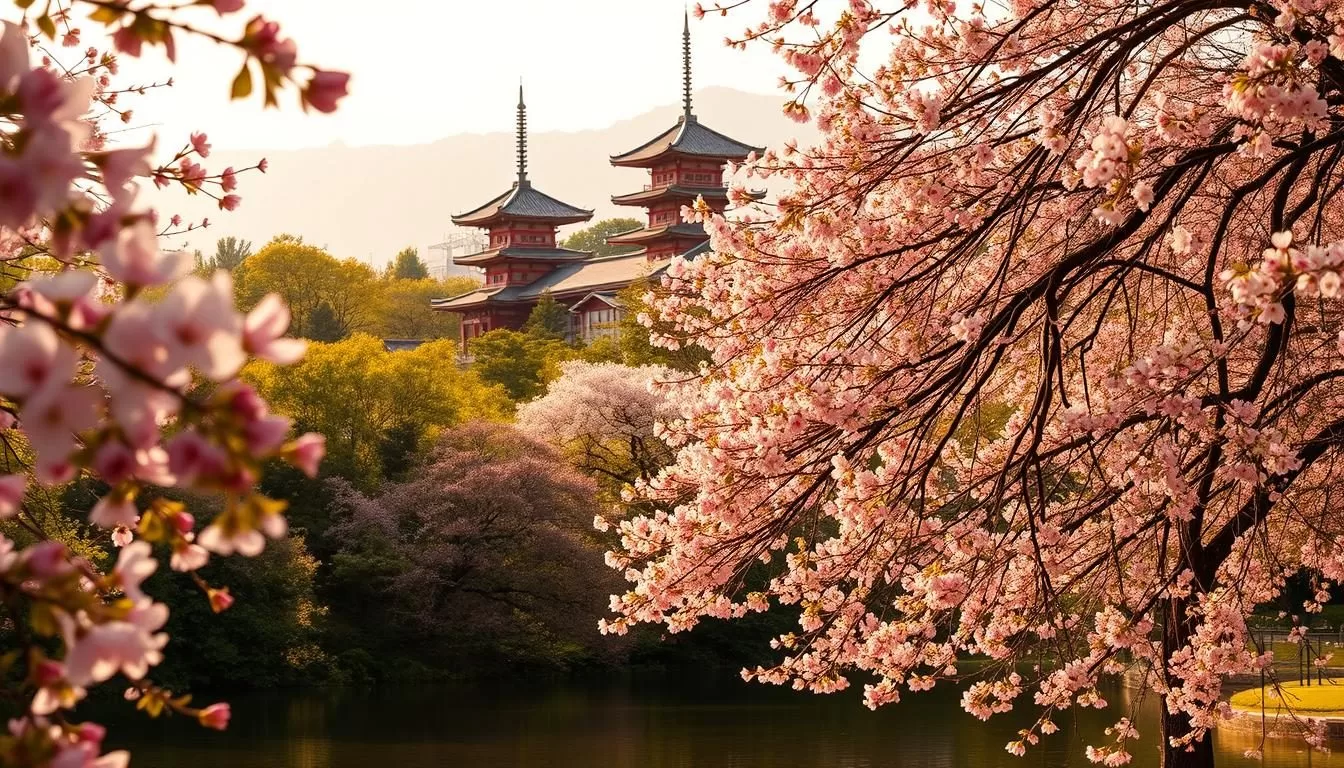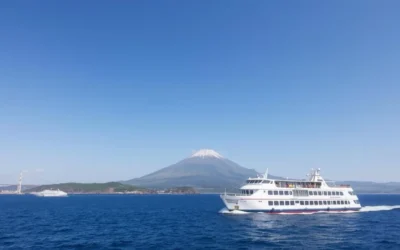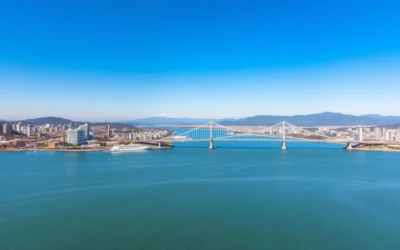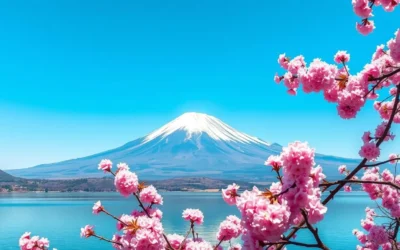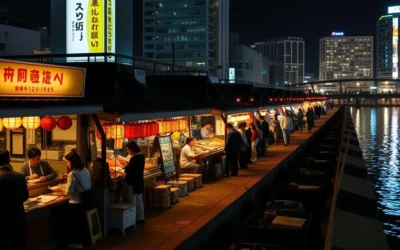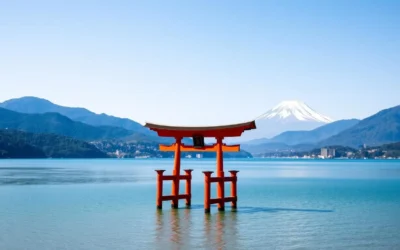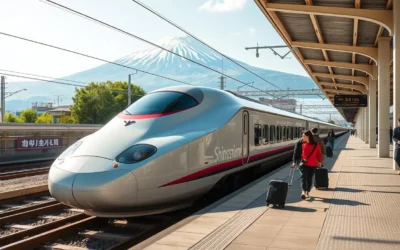✓ Accommodations✓ Flights✓ Rental Cars
Are you ready to immerse yourself in the rich history, art, and culture of Kyōto? With its walkable streets and scenic landscapes, Kyōto is a city that invites exploration. To make the most of your trip, understanding the local seasonal patterns is crucial.
As you plan your travel to this enchanting destination, knowing the weather and time of year will help you catch the city’s most spectacular events and festivals. Whether you’re drawn to the beauty of spring cherry blossoms or the vibrant foliage of fall, this guide will help you navigate Kyōto’s seasons and make the most of your visit.
By considering the local climate and seasonal highlights, you can create a trip that’s tailored to your preferences, ensuring a memorable experience in this ancient capital.
Understanding Kyoto’s Four Distinct Seasons
Understanding the seasonal changes in Kyoto is crucial for planning a memorable trip. Kyoto’s climate is characterized by four distinct seasons, each bringing its own unique charm and challenges.
Kyoto’s Unique Climate Patterns
Kyoto experiences a temperate climate with seasonal variations that significantly impact the travel experience. The city’s weather patterns are influenced by its geographical location, with cold winters and hot, humid summers. From spring cherry blossom festivities to autumn foliage, each season offers a distinct experience.
How Weather Impacts Your Travel Experience
The weather in Kyoto doesn’t just determine your wardrobe; it fundamentally shapes your travel experience. For instance, during rainy periods, particularly in June and early July, outdoor exploration takes on a different character. Misty landscapes create a mysterious atmosphere, but may limit photography opportunities. Here’s how different weather conditions can impact your trip:
- Rainy periods can create misty landscapes, adding a layer of mystery to your exploration.
- Extreme heat in summer can make walking tours challenging, especially in areas with limited shade.
- Seasonal weather patterns influence crowd levels at major attractions, with cherry blossom season being the peak tourist season.
- Your accommodation choices may be affected by the season, with traditional ryokans feeling chilly in winter or hotels being more desirable for their air conditioning during summer.
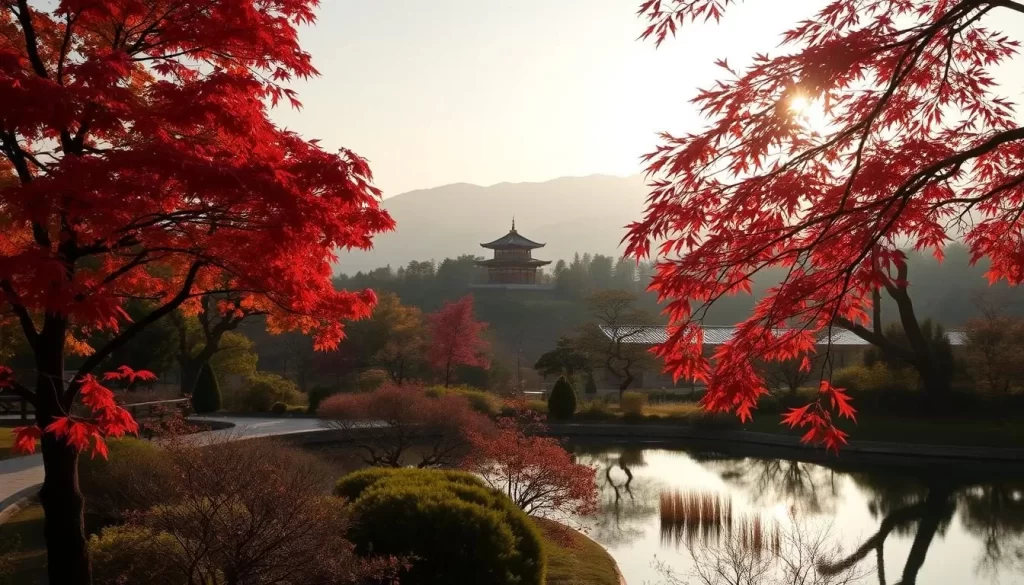
Spring: Cherry Blossom Magic
As spring unfolds in Kyoto, the city transforms into a vibrant canvas of colors and cultural experiences. The ideal temperatures during this season make it perfect for exploring Kyoto’s rich cultural heritage, including its numerous shrines, temples, and beautifully maintained gardens.
Cherry Blossom Festivals and Hanami
Spring in Kyoto is synonymous with cherry blossom viewing, or “Hanami.” The city hosts various cherry blossom festivals, where locals and visitors alike gather to admire the beauty of the blossoms.
Weather Conditions: March to May
During spring, Kyoto’s weather is mild and pleasant, with temperatures gradually warming up from March to May. This makes it an ideal time for outdoor activities.
Popular Spring Attractions and Activities
Kyoto offers a range of activities during spring. You can enjoy boat rides along the cherry-lined Okazaki Canal, explore Arashiyama’s bamboo grove and cherry trees, or visit temples like Kiyomizudera and Ninnaji, which host special spring exhibitions.
| Attraction/Activity | Description |
|---|---|
| Okazaki Canal Boat Ride | Admire cherry blossoms from a unique water-level perspective. |
| Arashiyama Bamboo Grove | Explore the serene bamboo grove complemented by blooming cherry trees. |
| Kiyomizudera Temple | Visit this iconic temple during its special spring exhibitions. |
Spring in Kyoto is a celebration of beauty and culture, offering something for everyone to enjoy.
Summer: Navigating Heat and Humidity
Summer in Kyoto is a season of contrasts, marked by sweltering heat and spectacular festivals. While the weather can be challenging, the city’s cultural events and traditions make it a fascinating time to visit.
Rainy Season (Tsuyu) and Typhoon Preparedness
Summer begins with the rainy season, or Tsuyu, which typically lasts from mid-June to early July. This period is followed by a heightened risk of typhoons. Visitors should be prepared for sudden rain showers and potential typhoon warnings.
Summer Temperatures and Humidity Levels
July and August are the hottest months, with temperatures often reaching above 35°C (95°F) and humidity levels making the heat feel even more oppressive. Staying hydrated and taking breaks in cool spaces is essential.
Summer Festivals and Cultural Events
Despite the challenging weather, summer in Kyoto brings some of Japan’s most spectacular festivals. The Gion Matsuri in July is a highlight, featuring a month-long celebration that culminates in the Yamaboko Junko parade. Other events include the Daimonji Festival in August and evening illuminations at various temples.
- The Gion Matsuri is one of Japan’s oldest and most famous festivals, dating back to 869 CE.
- The Yamaboko Junko parade features massive wooden floats weighing up to 12 tons.
- August’s Daimonji Festival offers a spectacular nighttime display with giant bonfires.
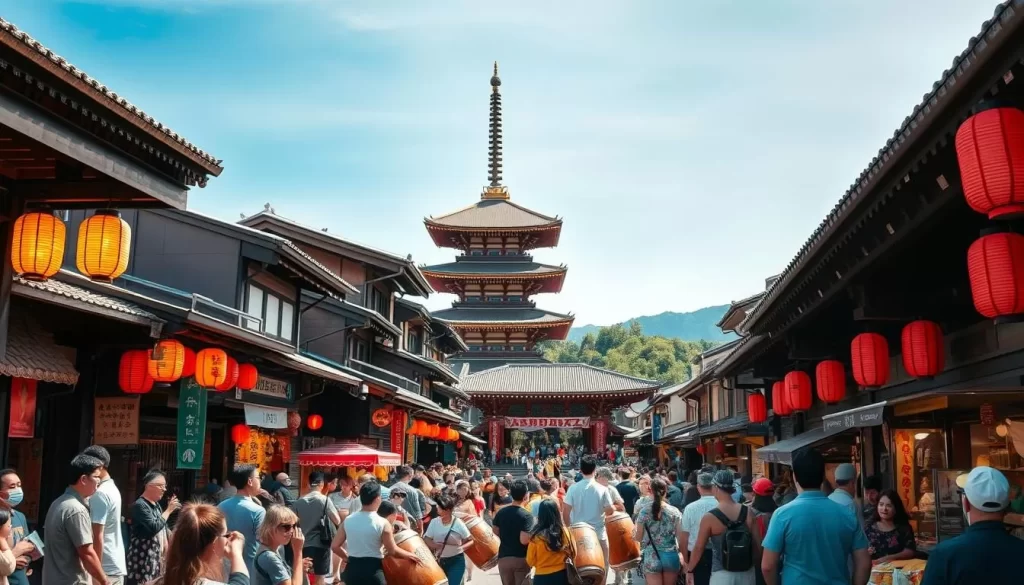
Fall: Nature’s Kaleidoscope
Fall in Kyoto is a spectacle of nature, with the city’s landscapes turning into vibrant hues of red, orange, and gold. This season highlights cultural events, revealing Kyoto’s unique heritage.
Autumn Foliage and Leaf-Viewing Spots
Visitors flock to temples and gardens to witness the breathtaking autumn foliage. Popular spots include Kiyomizudera, Kodaiji, and Eikando, which offer stunning views of the changing leaves.
Weather Conditions: September to November
During the fall season, Kyoto’s weather is generally mild, with comfortable temperatures ranging from 10°C to 20°C (50°F to 68°F). You can expect clear skies and gentle breezes, making it ideal for outdoor activities.
Fall Festivals and Cultural Experiences
The fall season is a time for numerous cultural festivals, including the Jidai Matsuri on October 22nd, featuring a historical procession with participants dressed in traditional costumes. You can also enjoy:
- Special evening illuminations at temples like Kiyomizudera and Kodaiji
- Traditional tea ceremonies incorporating seasonal themes and wagashi
- The Kurama Fire Festival, a dramatic autumn event with flaming torches
- Seasonal cuisine featuring matsutake mushrooms, chestnuts, and persimmons in traditional kaiseki meals
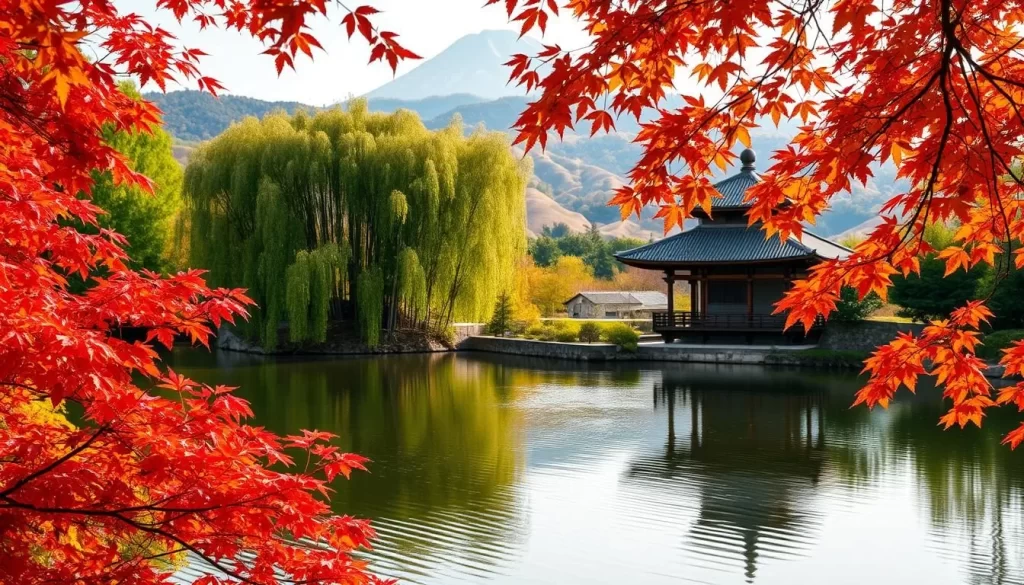
Winter: Tranquil and Less Crowded
Experience Kyoto’s winter charm, where the cold weather is offset by the warmth of its hot springs, delicious seasonal cuisine, and festive atmosphere. You can enjoy a more peaceful visit to the city’s famous landmarks without the crowds that are typical during other times of the year.
Winter Weather and Temperature Ranges
Kyoto’s winter, spanning from December to February, is characterized by cool temperatures, with average highs around 10°C (50°F) and lows around 2°C (36°F). You should pack warm clothing to enjoy your visit comfortably.
New Year’s Celebrations and Winter Illuminations
The New Year (Shogatsu) is a significant event in Kyoto, with many temples and shrines hosting special ceremonies and events. You can also enjoy the beautiful winter illuminations (Akari) that light up the city’s gardens and temples, creating a magical atmosphere.
Enjoying Hot Springs and Indoor Activities
Kyoto and its surroundings offer numerous hot springs (onsen) and indoor activities to warm you up during the cold winter months. You can visit nearby towns like Kurama and Kibune for a day trip or enjoy the luxury of hotel hot springs within the city.
| Activity | Location | Description |
|---|---|---|
| Hot Springs | Kurama, Kibune, and city hotels | Relax in natural hot springs, a perfect way to warm up |
| Museum Visits | Kyoto National Museum, Museum of Traditional Crafts | Explore Kyoto’s rich cultural heritage in world-class museums |
| Culinary Experiences | Restaurants throughout Kyoto | Savor seasonal dishes like yudofu (hot tofu) and nabe (hot pot) |
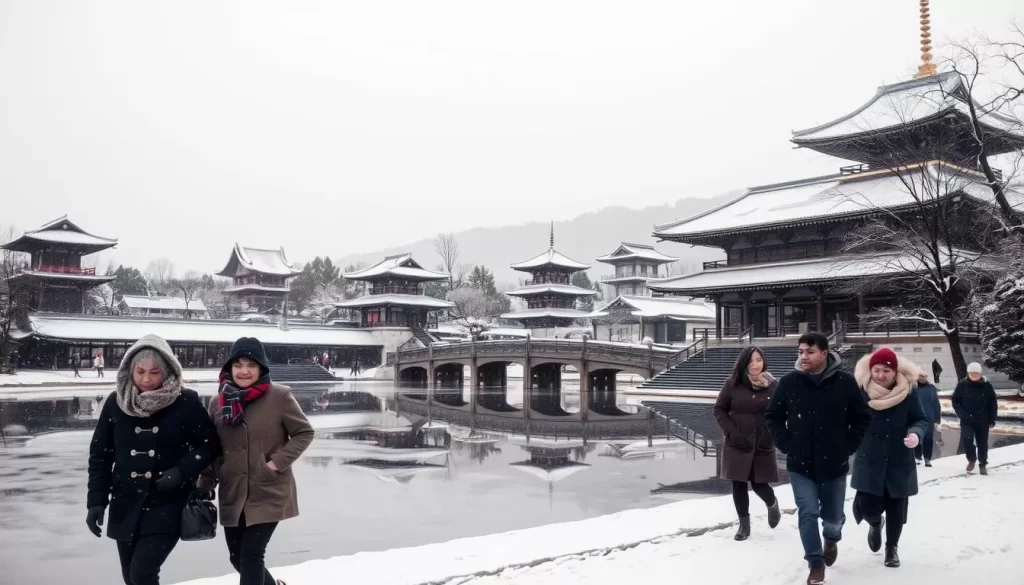
Kyōto Prefecture, Japan: Best Months for a Weather-Savvy Trip
Kyoto’s climate varies significantly throughout the year, making some months better than others for a visit. Understanding the seasonal changes is crucial for planning your trip.
Optimal Months for First-Time Visitors
For those visiting Kyoto for the first time, spring (March to May) and fall (September to November) are considered the best times. These seasons offer mild temperatures and fewer crowds compared to the peak summer months. Spring is famous for its cherry blossoms, while fall boasts stunning autumn foliage.
Weather Considerations for Photography Enthusiasts
Photography enthusiasts should consider the unique lighting conditions each season offers. Spring and fall provide the most photogenic natural elements, with cherry blossoms and autumn foliage creating stunning foregrounds for temple architecture. A comparison of the best seasons for photography is shown below:
| Season | Best For | Lighting Conditions |
|---|---|---|
| Spring | Cherry Blossoms | Soft, warm light |
| Fall | Autumn Foliage | Golden hour, misty mornings |
| Winter | Clear Skies, Snow | Crisp, clear light |
Seasonal Packing Guide for Kyoto Travelers
Kyoto’s climate varies significantly throughout the year, making a seasonal packing guide a valuable resource for travelers. Understanding the weather conditions during your visit will help you prepare and make the most of your trip.
Spring Essentials
In the spring, Kyoto’s weather is mild, with temperatures gradually warming up. You should pack light layers for your trip, including a waterproof jacket for unexpected rain showers. Comfortable shoes are a must for walking.
Summer Must-Haves
Summer in Kyoto is hot and humid, with occasional rain. Pack breathable clothing and don’t forget your sunscreen and a hat to protect yourself from the sun. Insect repellent is also a good idea.
Fall Layering Strategies
Autumn in Kyoto brings comfortable temperatures and stunning foliage. Pack layers for your trip, as the temperature can fluctuate significantly between day and night. A warm coat may not be necessary, but a fleece or sweater is a good idea.
Winter Warmth Necessities
Winter in Kyoto can be chilly, especially in the mornings and evenings. Pack warm clothing, including a coat, gloves, and a hat. Thermal undergarments are also recommended, as Japanese buildings can be cold.
Avoiding Crowds: Strategic Timing for Your Visit
Kyoto, a city steeped in history and culture, is best enjoyed when you can explore its landmarks without the hustle and bustle of tourist crowds. To achieve this, understanding the peak and off-peak tourist seasons is key.
Peak Tourist Seasons to Be Aware Of
Peak tourist seasons in Kyoto, typically during spring (March to May) and autumn (September to November), attract large crowds due to the city’s famous cherry blossoms and autumn foliage. Visiting popular sites during these times can be challenging due to the sheer number of tourists.
Off-Peak Advantages and Considerations
Visiting Kyoto during off-peak seasons, such as January-February and June, offers several advantages. You can enjoy a more peaceful experience, lower hotel rates (often 30-50% less than peak season), and easier reservations at popular restaurants. Moreover, photography becomes more rewarding with fewer crowds, and temples and gardens take on a serene atmosphere.
| Season | Characteristics | Advantages |
|---|---|---|
| Peak Season (Spring & Autumn) | Large crowds, cherry blossoms, autumn foliage | Iconic seasonal experiences |
| Off-Peak Season (Winter & June) | Fewer tourists, lower hotel rates, serene landscapes | Peaceful exploration, cost-effective |
By planning your trip during the less crowded periods, you can have a more authentic and enjoyable experience in Kyoto. Whether it’s strolling through less-visited neighborhoods or enjoying the city’s natural beauty, avoiding the crowds can significantly enhance your travel experience.
Must-Experience Seasonal Festivals and Events
Kyoto transforms with the seasons, offering a unique array of festivals and events that showcase its cultural depth. As you plan your trip, consider experiencing these seasonal celebrations to enrich your travel experience.
Spring Cherry Blossom Celebrations
Spring in Kyoto is synonymous with cherry blossom festivals, or Hanami. Enjoy the breathtaking beauty of blooming cherry blossoms at popular spots like Maruyama Park and Philosopher’s Path.
Summer Gion Matsuri Festival
The Gion Matsuri is one of Kyoto’s most famous festivals, held in July. This month-long celebration includes parades of elaborate floats, traditional performances, and street food.
Fall Foliage and Cultural Festivals
Autumn brings vibrant foliage to Kyoto, with many temples and shrines hosting cultural festivals. Visit spots like Kinkaku-ji Temple to witness the stunning autumn colors.
Winter New Year’s Celebrations
Winter in Kyoto is a time for New Year’s celebrations, or Oshogatsu. Many temples and shrines host special events, including the traditional bell-ringing ceremony, Joya no Kane, on New Year’s Eve. Participate in New Year‘s visits to shrines and temples, a significant cultural tradition in Japan.
The New Year period is also a time for unique cultural experiences, such as the Kemari Hajime ritual at Shimogamo Shrine, where participants play an ancient form of football in traditional attire.
Conclusion: Planning Your Weather-Perfect Kyoto Adventure
Embracing Kyoto’s seasonal rhythm is essential to making the most of your travel experience. Kyoto is special in all seasons, but spring and fall are ideal for visiting. The weather is nice, and nature shows off its beauty, from cherry blossom blooms to vibrant fall colors.
When planning your trip, consider your personal preferences: the ephemeral beauty of cherry blossoms, the vibrant energy of summer festivals, the fiery colors of autumn, or the peaceful tranquility of winter. Balance your desire for ideal weather conditions with considerations about crowds and accommodation costs. By doing so, you’ll enjoy the best time to experience this enchanting city’s culture and things to do.
Choose the best time to visit Kyoto, and you’ll find it’s a great place to be, with mild weather and beautiful scenes, along with cultural events. Enjoy your Kyoto adventure!
The above is subject to change.
Check back often to TRAVEL.COM for the latest travel tips and deals.
